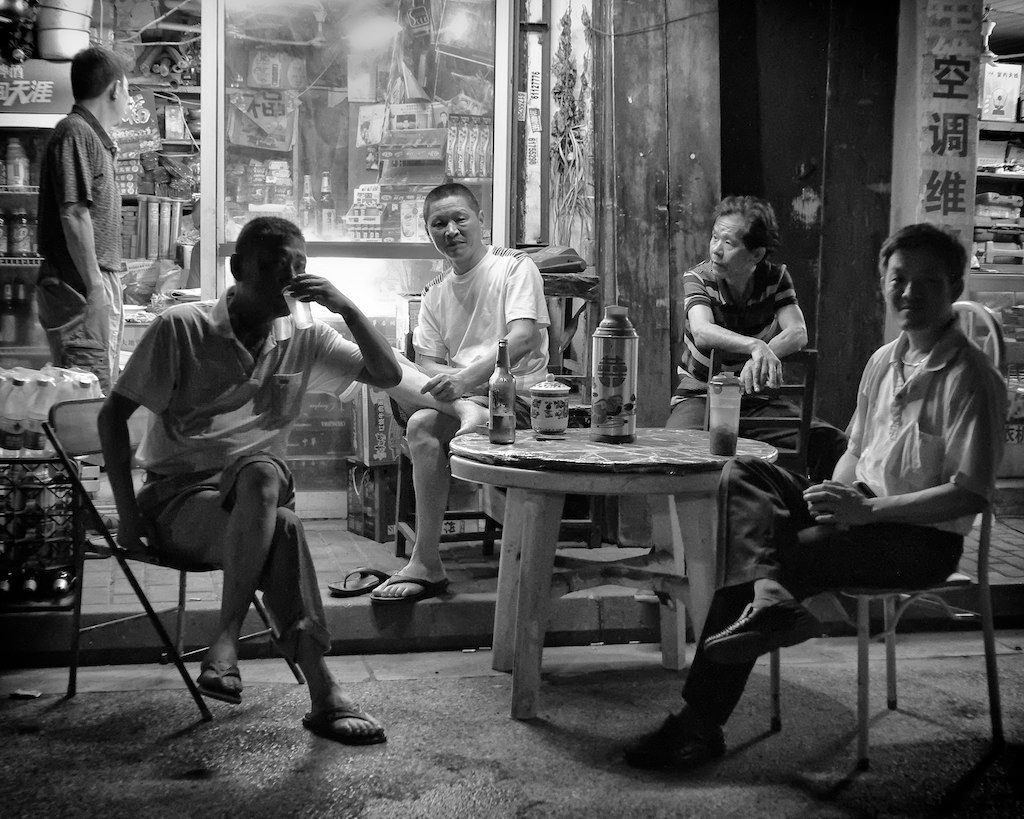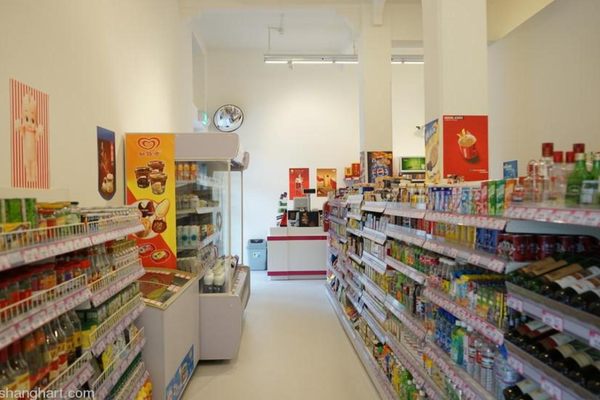Are China’s Days of Hot Drinking Water Over?
Bottled water or thermos—pick a side.

Ask for a glass of water in an American or European restaurant and you will almost surely be served something room temperature or much colder. But that’s not the case everywhere. Take China, for example. In New Method Chinese, a 2009 language textbook that also summarizes Chinese cultural habits for a Western audience, it says, “For most people living in China hot water (rè shuǐ) is an essential part of their daily life. They always boil water daily and store it in a thermos (rè shuǐ píng) to keep the water warm for the day.” No matter the weather, the default temperature for drinking water in China is lukewarm to hot—but it may not stay this way.
“The thermos is to the hot water devotee what the mohawk is to the punk rocker, what the polo neck sweater is to the art student,” Zhang Guowei, a communications studies scholar from East China Normal University in Shanghai, recently wrote.
This deep-seated tradition goes back to a fundamental precept of traditional Chinese medicine: that cold water is bad for your health. “Drinking cold water is not good for the body,” says Nan Lu, founder and president of the Traditional Chinese Medicine World Foundation in New York City. Chinese traditional medicine, he says, divides food and drink into five “essences” or “natures”: cold, cool, neutral, warm, and hot. These do not literally map onto temperature, but rather onto the impact they have on the body. For example, beef is considered hot, rice is neutral, and raw food is cold.
“Each organ has its own type of energy,” Lu says. “The stomach does not like cold essence, cold-type energy. Some people feel dizzy after eating just a salad, that’s because salad is a cold essence food and feeling dizzy is a typical effect of cold-type foods.” Cold water falls into this category, so traditional medicine recommends warm or hot water to prevent upsetting the stomach energy. This idea has been passed down since at least 200 B.C.

It’s not just that cold water is considered harmful, but that hot water is seen to have active benefits. When a cholera epidemic broke out in northern China in 1862, one folk explanation was that the south was spared because southerners drink more hot water. The “exaggerated tales of the powers of hot water” had already spread around the country, Guowei writes. “No longer was hot water just a way to improve one’s health. It was now a matter of life and death.”
By the 1930s water temperature became a matter of civic debate. Chinese society was undergoing profound cultural change as a result of contact with the West and Japan, as well as the rise of communism in the countryside.
To counteract both Western capitalist values and communist ideology, the Republican government led by Chiang Kai-shek launched a campaign called “The New Life Movement.” In 1935, the New Life Publishing House released “The Catalogue of the Requirements for the New Life Movement”—96 rules of conduct that reflected neo-Confucian values. Many of these involved personal hygiene—“Button your clothes neatly,” “Clean your face”—while others considered manners—“Do not smile at funerals,” “Stand in line to buy train tickets.” The catalogue was crystal clear on the temperature of drinking water. Hot.
There were a great many things that the communist movement rejected—private property, Confucianism, Chiang. But the opposed ideologies agreed on hot-water drinking. Between 1937 and 1945, Mao Zedong and other top leaders actively promoted the consumption of hot water among Red Army troops. Traditional medicine played a role in this, but, according to Pinghua Zhou, a doctor at the Fourth Hospital in the southern Chinese city of Changsha, so did modern public health. “At the time, especially in the countryside, water was taken straight from natural sources like rivers or lakes,” she says, “and there was no way to process it or sanitize it, so it could lead to diseases like dysentery.”

When communists seized power in 1949, the People’s Republic of China government established free hot water services in schools, factories, and government departments across the country. Today the availability of hot water in public spaces is still something that sparks curiosity in foreign visitors.
Hanchao Lu writes in the 1999 book Beyond the Neon Lights: Everyday Shanghai in the Early Twentieth Century that before the spread of gas and electric stoves, most households could not afford to boil water at home. Instead they bought it from hot water stores known as laohuzaos or “tiger stoves.”
Named for their large stoves, with tiger-eye-shaped furnace chambers and tail-like chimneys, laohuzaos served a role not unlike European cafes, as places for social aggregation. “Every household in the neighborhood was a customer,” Lu writes. “Especially in Shanghai’s bone-chilling winter, people flocked to the laohuzao and in the evening often formed a queue in front.” It was the same during the summer, when people brought their own chairs to sit near the stoves.
There were about 159 hot water stores in Shanghai in 1912. By 1936, two years after the publication of the rules of conduct, it was up to more than 2,000. They’re gone today, replaced by home kettles, thermoses, and public hot water dispensers.
“When I was in China in December visiting factories,” says Charlie Melvoin, an American entrepreneur who often visits China for business, “it was amazing to see that in addition to lockers for the workers to store their belongings, the factories have racks for all the hundreds of people to store their thermoses. It’s that engrained in daily life.”
“Laohuzao” are no longer relevant, but many elderly still remember. #Shanghai http://t.co/KJvcHNOG4B pic.twitter.com/ggMSX13rDQ
— Nine Shanghai (@ShanghaiCallCen) January 28, 2014
But things change when Chinese people travel abroad. According to a recent study, one of the most common complaints filed by Chinese tourists is about the lack of hot water kettles in hotel rooms. The problem was explored in the 1998 comedy Be There or Be Square, by director Feng Xiaogang, the second most successful movie ever released in China, after Titanic. “America is not as comfortable as China. You guys have to cope,” a tour guide explains to a delegation visiting Los Angeles in a famous scene. “You should have been prepared to suffer before you come to the U.S. If not, you’d better not come.”
“Drinking warm water helps your digestion and that’s very important when traveling,” Nan Lu explains. “That’s why Chinese tourists in Europe carry their own hot water bottles and then go to places like Starbucks to get them filled. But now some young people are choosing to drink cold water.”
Indeed, as foreign food habits—cheese, wine, coffee—made their way into China with the economic liberalization of the 1990s, cold water came with them. The change took some time—it takes a lot of water to move a ship—but by 2013, China had become the world’s largest market for bottled water, surpassing the United States. Some explain that this is partly fueled by concerns over the pollution of tap water, but part of it is also generational change.
As explained in 2017’s Cultural Change From a Business Anthropology Perspective, edited by Maryann McCabe and Elizabeth K. Briody, Chinese society is currently divided in its belief in the hot and cold edicts of traditional medicine. It seems that cold water is ascendant.
Last year, Zhao Mingyi, the drummer of Black Panther, one of the country’s most popular rock groups of all time, shared a picture online in which he held a hot water thermos after a concert.
Photo of 50-year-old Chinese #rockstar Zhao Mingyi holding a #thermos becomes a viral symbol of aging https://t.co/CPiwrAiRGm pic.twitter.com/fM4nK4yhvY
— Sixth Tone (@SixthTone) August 25, 2017
The post received 10 million views in 24 hours and sparked a social media debate. Did the thermos show that Zhao is over the hill, or is drinking hot water cool again? There were hundreds of expressions of sympathy for getting older in a rapidly changing world, but online searches for thermoses also spiked, driven mostly by people under 30. Since then, many fans of Black Panther have been carrying thermoses to their live performances. What that really means for the future of hot drinking water is anyone’s guess.
Gastro Obscura covers the world’s most wondrous food and drink.
Sign up for our regular newsletter.






































Follow us on Twitter to get the latest on the world's hidden wonders.
Like us on Facebook to get the latest on the world's hidden wonders.
Follow us on Twitter Like us on Facebook